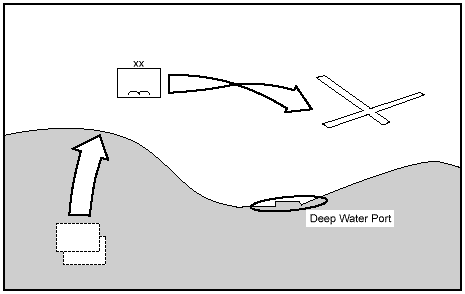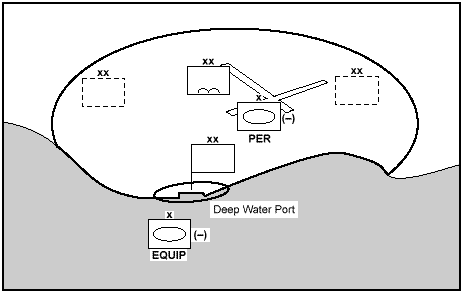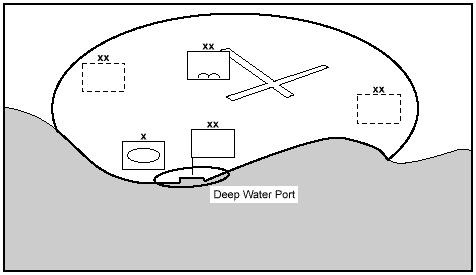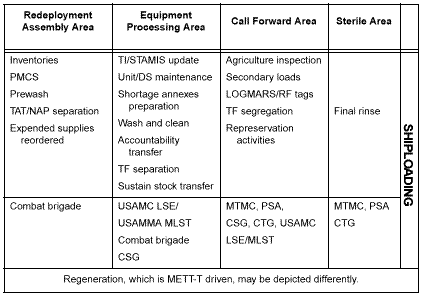CHAPTER 7
Employment, Redeployment,
and Regeneration
Employment of APA combines the efforts of its subordinate battalions to perform tactical tasks as part of a JTF or combined force. The key to successful operations is the brigade's ability to synchronize maneuver battalions and integrate CS and CSS combat multipliers in support of the overall brigade effort. Upon the successful completion of operations, the APA brigade must be redeployed. Redeployment is the movement of the APA forces from a theater of operations to follow-on designated CONUS or OCONUS locations. Regeneration is the rebuilding of the force for future conflict.
EMPLOYMENT
The APA brigade will use its unique capabilities to conduct combat operations across the range of military operations. It will operate in a wide range of political, military, and geographical environments. The employment phase-the operational use of the heavy brigade-begins when the brigade is tactically and logistically prepared and has moved into the TAA. It ends with the cessation of hostilities.
Deployment
Although the APA brigade may be deployed independently, it is normally deployed incrementally as part of a larger force. The installation, its higher headquarters, other armed services, the host nation, and units already in the AO assist the brigade. It must be able to reassemble rapidly into a division-size force and establish the basic battle command and liaison functions with the responsible in-theater headquarters.
Mission
The APA armored brigade combines the efforts of its subordinate battalions to perform tactical tasks as part of a JTF or combined force. The key to successful operations is the brigade's ability to synchronize maneuver battalions and integrate CS and CSS combat multipliers in support of the overall brigade effort.
The armored brigade's primary mission is to close with and destroy enemy forces using mobility, firepower, and shock effect. It defeats enemy assaults by defensive fires, obstacles, mines, and counterattacks. Tactical missions of an armored brigade involved in an APA operation, both in war and MOOTW, include-
- Engaging and destroying enemy forces during standard armor operations using mobility, firepower, and shock effect in coordination with other arms.
- Conducting offensive and defensive missions.
- Providing security, reconnaissance, and antiarmor firepower to a light infantry, airmobile, or airborne division or the USMC during a contingency operation.
- Conducting, expanding, and sustaining a lodgment for follow-on forces in coordination with other arms and services.
- Reinforcing a lodgment established by the Army early-entry forces or by USMC amphibious assault units.
- Augmenting an amphibious deployment or operation.
- Providing an armored force capability to a Marine expeditionary force during a contingency operation.
- Reinforcing an ally with a credible force prior to hostilities and sustaining relations with allies and coalition partners through routine exercises and operations.
- Conducting a show of force.
- Establishing a sizeable combat force to enable closure of additional forces and supporting a higher commander's operation or campaign plan.
Capabilities
The brigade's capabilities include-
- Conducting sustained operations in all environments.
- Moving rapidly.
- Exploiting success and pursuing a defeated enemy as part of a larger formation.
- Conducting limited security operations, that is, screens and guards.
- Conducting defensive operations or delays in sector over large areas.
- Conducting offensive operations.
Limitations
Due to the density of organic tracked vehicles, the armored brigade has the following limitations:
- Dense jungles and forests, steep and rugged terrain, and significant water obstacles restrict its mobility.
- Urbanized terrain impedes maneuver.
- Substantial numbers of heavy equipment limit strategic mobility.
- It consumes significant amounts of supplies, especially Classes III, V, and IX.
Operations
The APA brigade is capable of conducting operations in peacetime, conflict, and war.
Force Projection Operations
Combat operations might begin well before the entire brigade is on the ground and combat- effective. With the exception of mobilization and demobilization, the following paragraphs discuss the stages of force projection operations as they apply to the armored brigade within the context of an APA operation. For more information on mobilization and demobilization, refer to FM 100-17.
Entry Operations.
Entry operations for the APA brigade will vary. Entry may be in direct support of a host nation or another forward deployed force. Force protection is a vital consideration. Although not always the case, the brigade will generally be unopposed. Examples of unopposed entry would be the conduct of a combined training exercise or a show of force. However, even the presence of sporadic sniper and mortar fire or the possible presence of ongoing guerilla activities will cause the brigade to organize for combat operations as a force protection measure. Unopposed entry may therefore involve a certain degree of ongoing hostile action in the AO. If other elements of a contingency force conduct initial entry operations (see Figure 7-1), the armored brigade is incorporated into the second stage-the buildup of forces-then into offensive or defensive operations. During buildup, the contingency force-
- Establishes a forward operating base.
- Closes the remainder of the force.
- Expands the lodgment.
- Links up with other joint and/or combined forces.
- Moves out to engage the enemy in offensive and defensive operations.
Combat Operations.
This stage of an APA operation consists of the actual mission or operation to be conducted. The armored brigade's operation begins when it is introduced into the airfield, beachhead, and/or port in the contingency area (see Figure 7-2). The brigade reinforces and supports its own or another unit's assault force and established lodgment. The brigade might conduct missions to-
- Defend US citizens and interests abroad.
- Support US foreign policy.
- Promote regional stability.
- Defuse a sudden crisis or contain spontaneous conflict.
- Conduct short-notice humanitarian assistance.
- Conduct short-notice disaster relief operations.
- Conduct noncombatant evacuation operations (NEOs).
- Conclude military operations on terms favorable to US interests and objectives.
Reconnaissance and force projection remain crucial to any operation the brigade conducts during this phase. Sufficient combat power is generated and tactical operations conducted to fully secure the lodgment area by expanding the security area out to the range of enemy indirect fire weapons. The armored brigade's forces are employed as necessary to destroy, delay, or disrupt enemy forces threatening the lodgment. Because the force buildup and combat action of this phase are the most critical points for brigade and higher staff planners, they must ensure that the brigade is fully resourced for the mission (see Figure 7-3).

Figure 7-1 - Example of Initial Entry Operations Prior to APA Arrival

Figure 7-2 - APA Equipment/Personnel Arrival into Secure Lodgment
Postconflict/Postcrisis Operations
Once combat operations are completed, the deployed brigade transitions into postconflict operations. It may be required to participate in the following activities:
- Restoring order.
- Reestablishing host nation infrastructure.
- Preparing for redeployment.
The armored brigade may be called upon to conduct any number of missions during postconflict operations. Battalions and companies from the brigade may be assigned separate missions over extended geographical areas. In these cases, the brigade will need to interact closely with the higher headquarters in theater and the host nation. The brigade should also consider the possibility of conducting MOOTW listed below. See FM 100-23 for a complete listing of MOOTW missions.
Noncombatant Evacuation Operations
NEOs remove threatened civilian noncombatants from locations in a host nation. They normally affect US citizens but may also include selective evacuation of host nation or other nationals. NEOs involve a swift insertion of a force and possible temporary occupation of an objective, followed by a rapid withdrawal.
The armored brigade options for NEOs depend on the operational environment. Host nation capabilities, to include airstrip facilities, will play a major role in determining force options. The brigade commander should consider a task organization option that provides both early response to a developing situation and the capability to quickly expand should the environment become more hostile. For more information on NEOs, refer to FM 90-26.
Shows of Force and Demonstrations
Shows of force and demonstrations lend credibility to US promises and commitments, increase the nation's regional influence, and demonstrate its resolve. They can take the form of combined training exercises, forward deployment of APA elements, or the actual introduction and buildup of the APA forces in a region.
Security Assistance
Security assistance operations are undertaken when a friendly or allied nation faces an imminent military threat. These operations normally focus on providing additional combat systems (weapons and equipment) or supplies. However, they may include the full range of security assistance, to include financial and training support. Some may require the deployment of combat systems, supplies, and personnel from APA (see FM 100-23).
Peacekeeping Operations
Peacekeeping operations support diplomatic efforts to maintain peace in areas of potential conflict. During this type of operation, the brigade deters violent acts by its physical presence at violence-prone locations. The brigade will accomplish this by conducting reconnaissance and security missions to collect information, to include occupying observation posts and conducting patrols (see FM 100-23).
Peace Enforcement Operations
These operations are intended to halt violence and reinstate normal civil activities. They often evolve into peacekeeping operations. When the brigade conducts this type of operation, it may be opposed by considerable numbers of billigerents in a situation that could suddenly deteriorate into combat. Brigade planners should consider force protection, evacuation, and the potential for offensive and defensive combat operations (see FM 100-23).
REDEPLOYMENT
For APA operations, redeployment is the movement of the APA forces from a theater of operations to follow-on designated CONUS or OCONUS locations. Prior to redeployment, the APA forces will turn in all issued APA equipment and supplies to USAMC/USAMMA or designated agencies. They will retain TAT and NAP. This discussion is limited to those areas that will affect the APA force. For additional information on redeployment, refer to FM 100-17.
Redeployment Process
The redeployment process begins after combat operations reconstitution, when the force closes upon the RAA. During redeployment, contracts for transportation of materiel and maintenance may be used extensively to regenerate the force. The force requests the supporting movement control agency to provide movement authorization to move from the TAA to the RAA. Redeployment for the APA forces is conducted in the following six phases. For more information on each of these phases, see FM 100-17.
- Reconstitution for strategic movement.
- Movement to redeployment assembly area and turn-in of APA equipment and supplies to USAMC/USAMMA.
- Movement to POE.
- Strategic lift.
- Reception at POD.
- Onward movement from POD.
Tactical Reconstitution
The CJCS may direct the CINC to replenish APA catastrophic losses. Tactical reconstitution of heavy brigade forces in theater will be from the CINC's in-theater on-hand assets. Actions must be taken to restore APA equipment to a desired level of readiness commensurate with mission requirements and available resources. Tactical reconstitution normally occurs in place and can vary in scope from replenishment of consumable supplies, ammunition, end items, and medical supplies to complete unit replacement. Though the APA forces have turned in equipment to USAMC/USAMMA, they must comply with all stipulations of the redeployment execution order.
Turn-In Procedures
After units have fixed, cleaned, and inspected their equipment and moved to the RAA, they initiate turn-in of APA equipment and supplies. Turn-in will be in accordance with the procedures coordinated by the ARFOR/heavy brigade commander and the representatives in the AO. Upon completion of equipment transfer to USAMC/USAMMA, brigade personnel will be manifested for deployment back to home station or another theater.
The objective of the brigade in this stage is to turn in equipment to USAMC/USAMMA or other designated organization and redeploy assets no longer needed. Postconflict requirements will have a great impact on the flow of these assets. The brigade must consider redeployment as a separate and distinct operation and that it may not be to home station but to another contingency AO. Force protection remains a crucial consideration during this phase.
Transfer of Accountability
After the completion of an operational mission, equipment will be moved to a predesignated staging area for transfer of accountability back to USAMC and USAMMA. In the staging area, accountable officers from USAMC, USAMMA, and the APA forces will transfer accountability of equipment. Retail STAMIS turn-in procedures should be used to facilitate accountability transfer from retail to USAMC.
USAMC will inspect, receive, dispose, or retrograde all accountable materiel turned in by the redeploying APA forces. The APA forces will account for all missing major items lost while in their custody or control. The departing units will turn in Classes I, II, III(P), IV, V, and IX supplies to USAMC and Class VIII to USAMMA. Materiel will be redistributed, retrograded, or disposed of in accordance with sound supply and economic procedures. Appendix A identifies procedures for turn-in of equipment.
REGENERATION
The regeneration process begins in theater prior to redeployment and continues after arrival at home station. The brigade may need to rebuild unit integrity, especially if recently engaged in a greatly dispersed operation during postconflict operations. The brigade will also need to account for all its equipment and soldiers prior to redeployment. Once back at home station, the brigade should focus on reestablishing itself at home station and reverting back to predeployment activities.
Because of the enormity of the requirement to regenerate major end items, the APA brigade equipment may require a retrograde back to a maintenance facility outside of the AO for refurbishment, replacement, and represervation prior to another deployment. The regeneration of APA equipment will require large-scale reassembly of supplies and maintenance of equipment and an extended period of time to accomplish. USAMC is responsible for regenerating the APA package for supplies and equipment, and USAMMA for medical materiel. The APA Battle Books provide more detailed information on regeneration requirements.
This section outlines the basic procedures required to regenerate the strategic capability of APA assets to predeployment standards in the contingency AOR. DA will provide supplemental guidance regarding APA regeneration conducted in a location other than the contingency AOR.
Strategic regeneration of APA assets begins prior to the end of hostilities. Detailed planning at every command level is essential to successfully restore the strategic capability represented by the combat brigade afloat. Total Army involvement is necessary-from the individual soldier to the DA level. Once the CJCS commits to a contingency, the ARFOR commander is responsible for planning the regeneration in concert with DA, USAMC, USAMMA, the supporting CINC, and other agencies.
Considerations
APA regeneration is a lengthy and complex process that involves many uncertainties. Because of the difficulty in sourcing major end items/stocks/supplies for APA, regeneration may be conducted in a location other than the contingency theater. The primary considerations for regeneration are to determine-
- To what extent it is required.
- Requirements for each unit.
- Support resources: units and elements to perform the function; availability of supplies and equipment; location; and identification of ships to support APA reload.
- Necessary actions: establishment of maintenance standard for regenerated APA equipment; review of inventories (sets, kits, outfits, prescribed load lists (PLLs), authorized stockage lists (ASLs), basic issue item); reorder of major end items; nonexpendables and sustainment stocks consumed or lost in combat; and separation of TAT/NAP by losing unit.
Key influences on the location to conduct APA regeneration are-
- Site requirements (space) for the different equipment/stock processing areas.
- Ability to sustain supporting forces.
- Location and capabilities of maintenance and port facilities.
- Condition of equipment and supplies being regenerated.
- Equipment and supply retrograde plans.
- Transportation requirements.
Preparation for regeneration of APA assets is driven by METT-T. Initial notification of intent to regenerate APA assets must be made early to allow sufficient time for planning sea LOC transit of required stocks/supplies to fill shortages.
Responsibilities
The nature and concept of APA operations will probably place the employment area at a considerable distance from CONUS. Regeneration, therefore, will require cooperation, coordination, and detailed planning to return the APA units undergoing regeneration to an operational status in a rapid manner.
Chairman, Joint Chiefs of Staff
With recommendations from the CINC, DA, USAMC, and USAMMA will decide whether or not to regenerate the combat brigade. CJCS will notify all responsible agencies of its decision.
Department of the Army
Department of the Army will-
- Specify maintenance standard for transfer from losing units to USAMC.
- Specify standard requirements codes/define force modernization requirements and end state structure.
- Direct sourcing actions, equipment, supplies, and funds.
- Determine time-line requirements for regeneration.
Army Service Component Commander
The ASCC will-
- Identify units and locations for the regeneration effort in concert with DA, USAMC, and USAMMA.
- Develop planning guidance for unit activities to accomplish regeneration (regeneration plan).
- Identify serviceable assets (stocks and equipment) to replace APA assets in association with USAMC/USAMMA.
- Determine regeneration location (in AOR or at another location).
US Army Materiel Command Logistics Support Element
The USAMC LSE will-
- Determine resources required to return APA assets back to predeployment operational levels, including all classes of supply except Class VIII.
- Assist the combat brigade in conducting serviceability and maintenance inspections.
- Assist the DS maintenance company in performing required repairs.
- Validate and requisition replacements for all equipment and supply shortages beyond the losing unit's ability to fill or replace.
- Act as HQDA executive agent to ensure unit equipment sets are configured and uploaded in accordance with authorization documents.
- Organize unit equipment sets in accordance with APA authorization documents in preparation for loading on ships.
- Coordinate changes to APA ship load plans with HQDA and MTMC.
- Reestablish APA STAMIS data bases.
US Army Medical Material Agency Medical Logistics Support Team
The USAMMA MLST will-
- Determine resources required to return APA medical assets back to predeployment operational levels.
- Assist medical units in conducting maintenance and serviceability inspections.
- Validate and requisition replacements for all equipment and consumable supply shortages beyond the losing unit's ability to fill or replace.
- Organize medical equipment sets in accordance with APA authorization documents in preparation for loading on the ships.
- Coordinate changes to APA ship load plans with HQDA and MTMC.
- Reestablish APA STAMIS data bases.
Military Traffic Management Command
MTMC will-
- Designate SPOEs and SPODs.
- Coordinate upload requirements with the CTG or establish contracts for stevedores and equipment required to support reload of APA ships.
- Serve as port manager with overall responsibility for the upload of APA ships.
- Provide port services as required.
- Develop stow plans based on commander's intent.
Army Service Component Commander COSCOM/CSG
The ASCC will-
- Provide C2 for APA regeneration.
- In compliance with USAMC LSE, USAMMA MLST, MTMC, and the combat brigade, establish an RAA, equipment processing area, call forward area (CFA), and a sterile area for APA regeneration to conduct maintenance, inventory, equipment and sustainment stock configuration, agricultural inspection/correction and equipment washing.
- Provide maintenance support to units undergoing regeneration within capabilities.
- Provide a PSA to assist APA vessel upload operations.
Combat Brigade Regenerating Units
These units will-
- Provide required security for the RAA.
- Assemble the combat brigade/regenerating units in the RAA.
- Conduct a maintenance inspection of all vehicles and equipment; conduct unit- and DS- level maintenance to correct deficiencies within capabilities; place repair parts requirements on requisition in coordination with COSCOM/CSG/LSE/MLST direction; update STAMIS software disks with current information.
- Inventory all supplies and equipment and prepare turn-in documentation in accordance with applicable regulations; reorder shortages in coordination with ASCC support command/COSCOM/CSG/LSE/MLST direction.
- Separate/segregate TAT/NAP equipment.
- Conduct preagricultural inspections.
- Wash and clean all equipment to meet US Department of Agriculture (USDA) standards.
- Move APA equipment to other marshalling areas directed by ASCC support command/COSCOM/CSG, USAMC LSE, and USAMMA MLST.
- Provide personnel to support the movement of APA equipment and sustainment stocks though the RAA and equipment processing area.
Army Composite Transportation Group
The Army CTG will-
- Establish port areas for reception, customs inspection, agricultural inspection, and loading of APA equipment and containerized sustainment stocks.
- Document cargo in cooperation with MTMC.
- Reestablish radio frequency (RF) tags.
- Serve as port operator as tasked by MTMC for upload of APA equipment and supplies.
Areas Of Activity
Table 7-1 depicts the four areas in which strategic regeneration activities occur. Because regeneration is driven by METT-T, various changes may occur in the areas or in the sequencing of activities within the areas.
Redeployment Assembly Area
Upon conclusion of the contingency mission, the combat brigade/regenerating units will close in and consolidate on a designated RAA to assess the readiness status of the equipment and stocks and begin initial preparations for redeployment. The RAA and all activities within it are under the C2 of the combat brigade/regenerating units. The units must-
- Separate and segregate TAT/NAP requirements brought from home station.
- Inspect all equipment and correct deficiencies.
- Inventory equipment to determine shortage requisition requirements.
- Prepare requisitions for all supplies/equipment expended during the contingency.
- Prewash all equipment.
Equipment Processing Area
The combat brigade/regenerating units will move to the equipment processing area as called forward by USAMC LSE and USAMMA MLST. Within the equipment processing area, the following actions/activities will occur:
- USAMC LSE/USAMMA MLST will conduct a joint inventory of all equipment and supplies in preparation for transfer of accountability.
- Shortage annexes will be prepared and equipment and supply requisitions verified.
- The losing unit and USAMC LSE/USAMMA MLST will conduct a technical inspection to ensure all equipment meets 10/20 standards. USAMC LSE and USAMMA MLST will assist the warfighter in correcting deficiencies.
- Sustainment stocks will be inventoried, requisitioned if required, and transferred to USAMC LSE and USAMMA MLST.
- USAMC LSE will upload STAMIS with current information.
- The combat brigade/regenerating units will wash and clean all equipment to meet USDA standards.
- When USAMC LSE and USAMMA MLST are satisfied with the state of readiness of the equipment and supplies, accountability will be transferred.
- The equipment processing area is under the C2 of the USAMC LSE. It may or may not be located within the confines of the port facility.
Call Forward Area
The PSA will move equipment and sustainment stocks to the CFA as directed by the port operator in coordination with USAMC LSE and USAMMA MLST. The USDA will conduct the agriculture inspection. Equipment failing inspection will move to a wash rack to be rewashed. Equipment passing the inspection will move to the LOGMARS/RF tag station to be married up with secondary loads and then moved to the represervation station for final represervation activities. Equipment is separated and segregated by task force for ship loading. The CFA is under C2 of the port operator in coordination with USAMC LSE and USAMMA MLST.
Sterile Area
The PSA moves equipment to the sterile area where, if required, it will undergo a final rinse prior to being loaded on the ship. When contract services are available, MTMC will contract for all required port-operating functions. If they are not available, the CTG will load all equipment onto the ship using PSA drivers. MTMC will document the upload, providing HQDA and USAMC LSE with deployment stow plans.
|
NEWSLETTER
|
| Join the GlobalSecurity.org mailing list |
|
|
|



